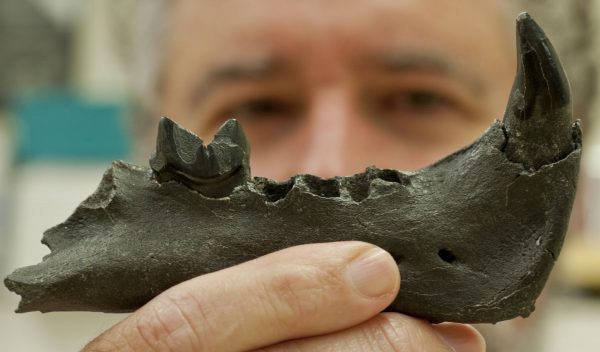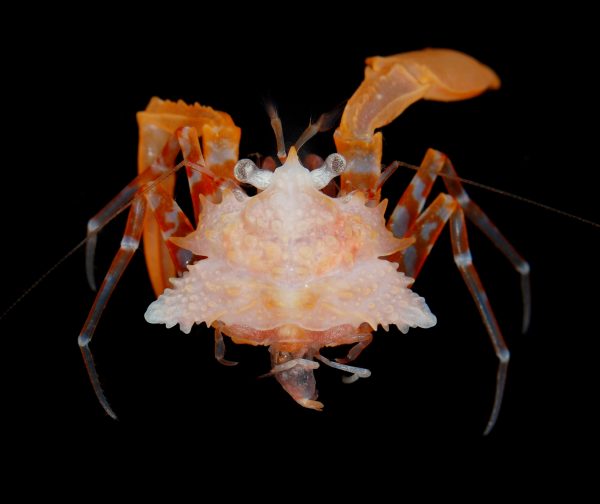
Florida Museum photo by Jeff Gage
A saber-toothed cat that roamed the southeastern U.S. 5 million years ago, the world’s oldest grape and a bizarre hermit crab were among more than 100 new species described by Florida Museum of Natural History researchers last year. Still, scientists say there are millions left to discover.
Driven in part by the urgency to document new species as natural habitats and fossil sites decline due to human influences, researchers from the Florida Museum described 16 new genera and 103 new species of plants and animals in 2013, with some research divisions anticipating higher numbers for 2014.
This new knowledge of species-level biodiversity provides a better foundation for conservation and ecological work, said Akito Kawahara, Florida Museum assistant curator of Lepidoptera.
“Natural history museums preserve important historical data that allows us to see how species have been affected by human-mediated changes to our environment,” Kawahara said. “It is important to build a record because once a species is gone, it is gone forever. As scientists, we are not only studying species, but providing a point of reference for ongoing and future research.”

Photo courtesy Arthur Anker
UF researchers discovered species from more than 25 countries on four continents, including 35 fossil crustaceans, 24 Lepidoptera, 17 plants (11 fossils), eight mollusks, two fossil mammals and one fossil bird, among others. Thirty-three additional species were identified in the museum’s collections by visiting researchers.
An online search shows the only other major research institution reporting similar information is the California Academy of the Sciences, which described 91 new species in 2013 and has averaged 115 per year since 2009.
“Traditionally this isn’t a number many research institutions have tracked,” said Florida Museum Director Douglas Jones. “But the extra emphasis on biodiversity due to degradation of natural habitats and accelerating extinction rate of plants and animals worldwide has placed a higher emphasis on researchers documenting and describing new species before they disappear.”
Don Davis, curator of Lepidoptera at the Smithsonian Institution’s National Museum of Natural History, said the Florida Museum has actively pursued the goals of all natural history museums, including discovering new organisms to better understand the current distributions and history of all life.
“The scientists there are providing not only new knowledge for a broad range of organisms, but also an excellent, well-documented specimen database for future researchers,” Davis said.
The Florida Museum’s specimen collections have been especially influential in sorting out the complex ecological and evolutionary history of land and sea life in tropical America, said Geerat Vermeij, a paleontologist with the University of California at Davis. He is one of many outside researchers who have utilized the museum’s collections for their research. Scattered among the museum’s mollusks collections are braille labels, which Vermeji, blind since childhood, uses along with his other senses to investigate invertebrates’ predator and prey relationships.
“To my mind, the Florida Museum houses one of the finest natural history collections in the U.S. and the world,” Vermeij said. “The work that scientists there are doing to describe species is very important, because all work on the evolution, history and ecology of life depends on this work.”
Although scientists often happen upon new species while working in museum collections or exploring in the field, recent museum biodiversity projects and collaborations have focused on discovering as many new species as possible.
The “All Catfishes” NSF-funded project led by the Florida Museum ended in 2009 with 430 species discovered and 285 papers published, although the inventory of over 300,000 specimens is still producing new species. Florida Museum ichthyology curator Larry Page, who led the worldwide, five-year catfish project, said researchers expect to identify another 350-500 species.
Special museum projects with a focus on taxonomic research are bringing science to areas of the world where it is currently needed most. With researchers working in Africa, South America and Asia, Page said the museum’s division of ichthyology is helping scientists in developing countries study species-level biodiversity by creating online inventories.
“Due to a lack of funding in developing countries for field work and museum visits, taxonomic and other scientific research has been stifled along with efforts to understand and manage freshwater ecosystems,” Page said. “By fostering cross-cultural collaborations between scientific, educational and government institutions, our projects are helping to overcome these limitations.”
Museum scientists utilized advanced taxonomic methods during recent biodiversity survey projects, including DNA bar coding, a process that uses a genetic marker to identify if an organism belongs to a particular species. Some of the new species discovered during these surveys prove rare discoveries still occur.
For example, during an international effort to document all animals and plants living on and in the waters surrounding the island of Moorea in French Polynesia, Florida Museum invertebrate zoology curator Gustav Paulay dredged from the deep sea a new hermit crab that exemplifies a rarely documented process in which hermit crabs move out of their shells and harden their bodies to resemble true crabs. Patagurus rex has a broad, armored body with pointy spines and long legs connected to large claws—making it one of the most distinctive hermit crabs discovered in decades, Paulay said.
“There is this idea that we can grab a field guide and work out there as scientists,” Paulay said. “But for large chunks of the world, those resources don’t exist and the science that would support those resources is just not there.”
This is especially true for museum scientists studying some of Earth’s smallest species in remote jungles of the Congo and isolated areas of Hawaii. Kawahara said new species of insects sometimes lead to powerful discoveries that affect other fields, including agriculture and medicine.
“Future research will include the investigation of a potential new species of moth in Hawaii that appears to delay plant aging by altering the process of plant senescence (aging) in leaves,” he said. “This moth could have potential for improving agriculture and extending the shelf life of some foods.”
Last year, many scientists looked for new species from the past. Museum researchers described 56 new species of fossil plants and animals. Among these, the world’s oldest-known grape species, Indovitis chitaleyae, discovered in 2005 and described in 2013, pushed the record of the Vitaceae (grape) family into the Late Cretaceous, about 66 million years ago.
Paleontology collections manager Richard Hulbert, who described the 5-million year-old fossils of Rhizosmilidon fiteae, a carnivorous saber-toothed cat from the same lineage as the famous Smilodon fatalis from the La Brea Tar Pits of Los Angeles, said there are still plenty of new species being found in the field of paleontology, though it is a more rare occurrence for scientists studying some living groups, such as birds and mammals.
“Today’s species represent only about 1 percent of life that ever existed,” said Bruce MacFadden, Florida Museum curator of vertebrate paleontology. “It is important to understand the other 99 percent of biodiversity that once inhabited the planet, because knowledge of the kinds of plants and animals that lived here in the past provide us with a framework for understanding today’s ecosystems.”